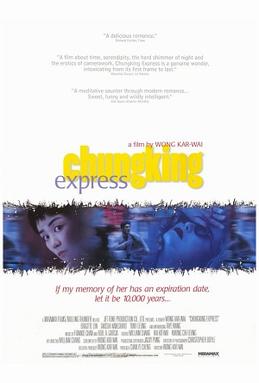In the British Film Institute's
Sight and Sound critics' poll of the greatest films of all time, Wong Kar-wai's
In the Mood for Love placed at No. 24, in a tie with
Rashomon (Akira Kurosawa, 1950) and
Ordet (Carl Theodor Dreyer, 1955). I have to admit that I wouldn't rank it quite so high, especially putting it on a par with the other two films, but its intense, elliptical love story -- one in which there is no nudity, no sex scenes, and in fact not even a consummation of the affair -- is certainly unique and challenging. It's a film whose claustrophobic settings occasionally reminded me of the below-deck scenes in
L'Atalante (Jean Vigo, 1934). The would-be lovers, Chow (Tony Leung Chiu-Wai) and Su Li-zhen (Maggie Cheung), are as trapped in their Hong Kong rooms as the newlyweds in
L'Atalante are on their river barge, with the additional limitations that they are trapped in their marriages, in their offices, and in the social conventions of the 1960s. In one marvelous sequence she is trapped in his room when their landlady, Mrs. Suen (Rebecca Pan), comes home earlier than expected and then stays up all night playing mahjong with the neighbors, preventing her from leaving and adding fuel to the gossip but also fueling their intimacy. It's a masterstroke that we never see their respective spouses or even receive direct confirmation of what Chow and Su Li-zhen suspect: that her husband and his wife are having an affair with each other. They can't redouble the scandal by openly pairing off with each other, and in the end the paralysis becomes so ingrained in them that they are unable to consummate their relationship even when they are liberated from their claustrophobic living arrangements. Wong makes the most of the cinematography of Christopher Doyle and Mark Lee Ping-bin, framing them in the clutter of the offices where they work, focusing intensely on them as they meet in restaurants, using a variety of techniques such as slow motion and swish-pans, always with the effect of emphasizing their alienation. The score is often exquisitely appropriate, with themes by Michael Galasso and Shigeru Umebayashi as well as pop recordings by Nat King Cole and others. The historical references -- the tension evident in Hong Kong as it approaches the handover by Britain to China, a 1966 newsreel featuring Charles de Gaulle, Chow's final scene in Angkor Wat -- strike me as an unnecessary attempt to give the relationship of Chow and Su a connection to something larger than just a frustrated love affair. The story is poignant and resonant enough without them.


























